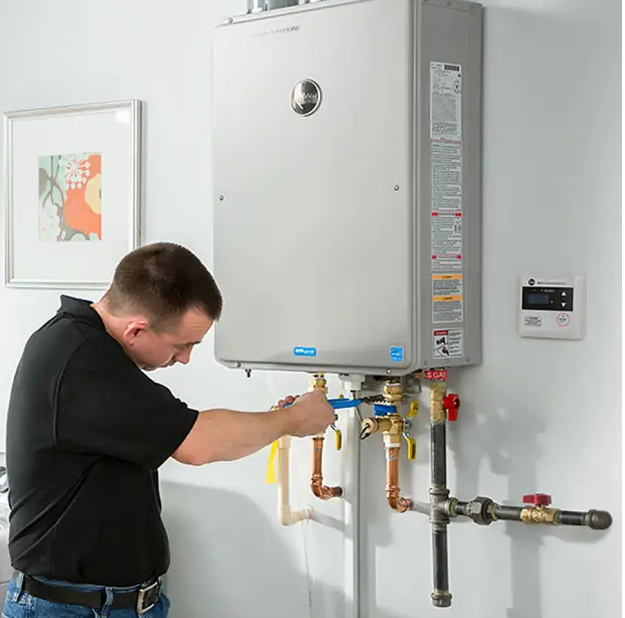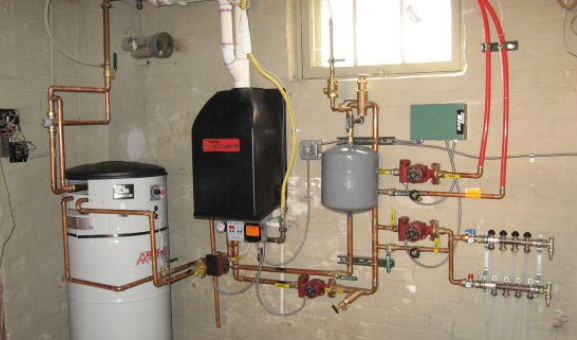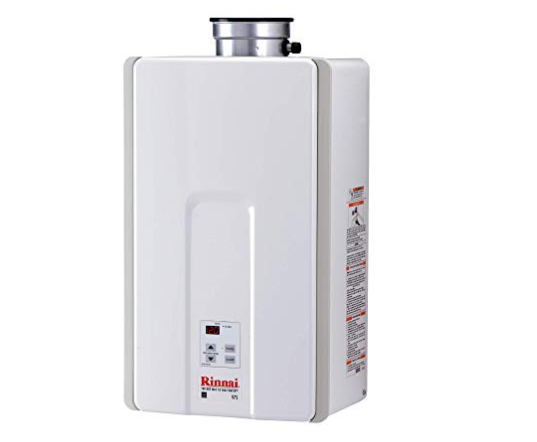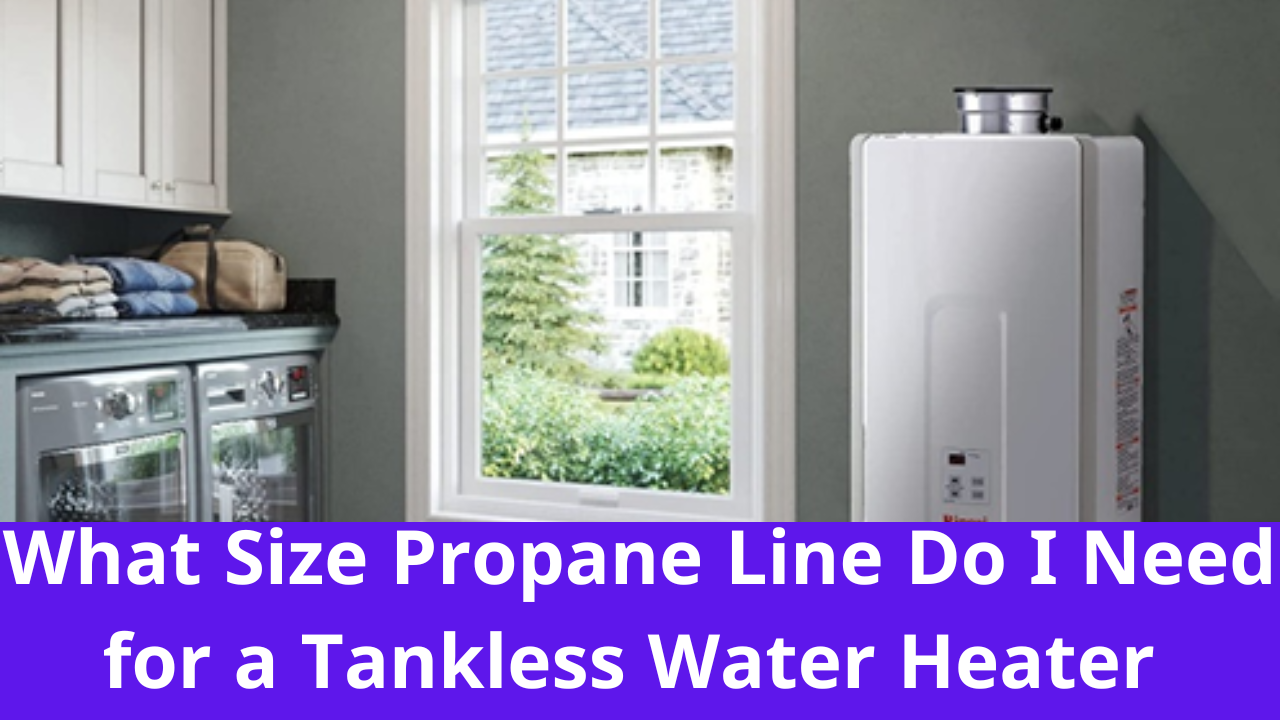What size propane line do I need for a tankless water heater? If you’re thinking about installing one, you might be wondering how much propane it will require and what type of propane line you should use. This article will teach you all you need to know about selecting the proper propane line for your tankless water heater.
Proper propane pipe is critical to properly operating your tankless water heater. In winter heating and water use in cold climates, the wrong size can lead to poor performance and even safety risks. Here’s how to figure it out: What size propane line do I need for a tankless water heater?
If you’ve been wondering if a tankless water heater can run on propane, it’s most likely because your home lacks a natural gas source. So, maybe you already use propane or are considering converting from electric water heating and want to go tankless.
Propane can power tankless water heaters (LP gas). Propane tankless water heaters, like natural gas ones, give rapid hot water on demand. Where natural gas utilities are unavailable, propane can be used. It is crucial to note that natural gas and propane models are not interchangeable.
There is a lot to consider when purchasing a propane tankless water heater. So, we’ve included some things you should know below: What size propane line do I need for a tankless water heater?
Considerations to Make Before Moving To Tankless Technology

If you’ve always used a storage-tank water heater, making the conversion to tankless technology necessitates a thorough examination of several crucial aspects. Here are six things to think about before making the switch and discussing with your contractor:
1 – Size Your Tankless Correctly
Your plumber will need to assess the appropriate size for your unit. The tankless water heater type chosen for any specific application will be determined by incoming water temperatures over the year.
2 – The Inhabitants’ Water Consumption Habits
In brief, the water heater must handle the coldest potential incoming ground water temperature in your area, which your plumber will compute and subtract from the target temperature to establish the maximum temperature rise, or “Delta T,” during 12 months.
They will then need to tally up the maximum flow rates of all the hot-water fixtures on your property. Your new tankless unit should be able to meet the demands of every fixture in your home, even if they are all running at total capacity simultaneously.
Your plumber can determine which tankless model is best for your home with this information.
3 – Please Don’t Overdo It
After installation, the hot-water setpoint temperature should be slightly higher than the highest temperature required for home use. Shower temperatures are often the highest, ranging from 104°F to 106°F. You don’t need to go much warmer, which may increase your risk of scalding.
Don’t be concerned about germs. Tankless water heaters, unlike storage tank-type water heaters, do not keep hot water where germs might thrive (Legionnaires’ illness). In fact, with each usage, tankless water heaters flush any internal water.
4 – Comply With Air Regulations
A tankless water heater, like any other, requires sufficient incoming air for the combustion process to function effectively and efficiently, optimizing energy savings. Many units are immediately vented, drawing air for burning from the outside. It can install others outside, depending on the conditions. Consult with your plumber to find the best remedy for your particular situation.
5 – Examine the Gas Supply
Tankless water heaters often require more gas than storage-tank competitors for a given application to meet the sudden demand for hot water without storage. Your plumber must ensure that your home has enough gas pressure for the unit to meet all of your gas needs.
Next, they should check to see if the gas line is large enough to send enough gas to the water heater. A 34-inch gas pipe is required for a standard tankless water heater. A 12-inch line may be suitable with sure tankless water heaters, such as the Noritz EZ Series, providing sufficient pressure, and the run length is short enough.
Just be sure your plumber considers all of the appliances on the gas line, not just the water heater. Installers should verify with local licensing norms and codes gas requirements and dimensions.
6 – Plan to Keep Water Quality High
Water quality is crucial for all water equipment, but water heaters are frequently the most affected. Water hardness, a measure of the minerals (magnesium and calcium) it contains, is noteworthy. When these minerals are heated, they precipitate out of the water and form crystals known as limescale, which can coat pipes.
The limescale works as an insulator, limiting heat transfer efficiency (the fraction of heat energy that moves from the burner to the water). Limescale can also increase thermal stress, reducing the water heater’s lifespan.
Limescale can be cleaned regularly by descaling, which involves flushing vinegar through the heat exchanger coils of the water heater to eliminate the accumulation. Finally, it’s critical to understand the local water quality and take actions to either treat household water or create a maintenance plan.
7 – Handle Condensation
When you install a high-efficiency, condensing tankless water heater, a byproduct of the combustion process is an acidic condensate, which must be appropriately managed before the water flows into the home drainage system. For proper disposal techniques, consult your local building codes: A neutralizer may be required to safeguard the plumbing inside the house.
Considering these variables when designing your tankless installation will ensure you have efficient, on-demand hot water for many years.
How to Install a Tankless Water Heater on a Propane Line

Several installations need to consider if you are considering a propane tankless water heater. Things needed to establish a propane line:
- Wrench for pipe
- Tube cutter
- Torch made of propane
Steps:
- Close the main water valve near the meter.
- Remove the existing water–supply pipes from the old water heater.
- Remove the old water heater and replace it with the new tankless heater.
- Connect the outdoor propane tank to the heater using threaded iron pipe; tighten all connections with a pipe wrench.
- Connect the threaded gas pipe to the heater using a union fitting.
- Connect the heater to the existing water supply line with a copper pipe. Solder the copper connections.
- Turn on the main water valve and double-check your work for leakage.
- Light the propane and plug the heater into an electrical outlet nearby.
- At the heater’s control panel, set the water temperature to 120 degrees Fahrenheit.
What Is the Size Gas Line Required For A Rinnai Tankless Water Heater? BUY ON AMAZON

Rinnai Tankless Water Heaters usually cause a 3/4 “gas connection to give enough gas to the burner on the unit. However, if adequate pressure and the gas line is sufficiently short, a 1/2 “Gas line, the most common size in the United States and Canada, can be used. This can transition from a tank-style to a tankless water heater faster, easier, and less expensive.
Rinnai designed their tankless water heaters to operate with a 34″ or 12″ gas line, as long as sufficient gas flow is available. If your tankless water heater installation requires a 12″ gas line, Rinnai has two words for you.
To protect performance and efficiency, Rinnai Tankless Water Heaters, unlike other tankless water heaters, are equipped with advanced technologies that automatically shut off the system when there is insufficient gas flow, thereby preventing system failure.
When paired with each of Rinnai’s Tankless Water Heaters, the maximum length for both 12″ and 34″ gas lines is listed in the table to the left. The Rinnai V75IN indoor tankless water heater is one of the greatest Rinnai Tankless Water Heaters.
Why Did We Select the Rinnai V75IN Tankless Water Heater?
Rinnai is a well-known brand with gas tankless water heaters. The product Rinnai V75iP Propane Tankless Hot Water Heater is a compact and portable unit designed for the modern homeowner. With a hot water flow rate of 7.5 GPM, this is one model you won’t want to pass up.
1. Exceptionally Ergonomic Design
With just one look at this device, you can tell that the firm has done its homework. It has a tiny footprint of 14 x 9 x 27 inches, making it appropriate for smaller and mid-sized houses with limited space.
The small size is the product of closed combustion and circular venting systems. They can also employ it in any commercial location because of its small size. It is less visible than tank-style water heaters and may be slipped into any corner. Furthermore, the excellent white appearance contributes to its visual appeal.
2. Extensive Performance
You’re mistaken if you assume that the device’s compact size shows that it sacrifices power! Even when used regularly, this product Rinnai V75iP Propane Tankless Hot Water Heater will provide a powerful performance. It is a powerful system in a small package, with an output rating of 180,000 BTUs and a flow rate of 7.5 GPM.
The enormous heating capacity means it can meet your home’s hot water needs. The device’s energy factor of 0.82 ensures optimal performance, and the temperature range of 98 to 140 degrees Fahrenheit allows you to select any temperature that meets your requirements.
3. Product with Low Upkeep
The second feature we’d like to emphasize is this unit’s low upkeep and simple installation. Rinnai uses concentric direct venting for this model, which allows it to be fitted even in tight quarters.
At the same time, we enjoy how it comes with a complete instructions manual that aids installation. Add a ten-year warranty on the heat exchanger and a five-year warranty on the parts, and you have a gadget that requires almost no maintenance.
4. Advanced Safety Functions
Regarding safety, the V75IN has a scale control system that prevents scale accumulation from harm. It also includes a temperature lock that regulates the amount of hot water produced.
Furthermore, the device includes a frost guard to ensure that water in the pipes does not damage them. It also has an electrical ignition system, saving energy and increasing gadget efficiency.
5. Environmentally Friendly and Adaptable
This tankless heater runs on both propane and natural gas, reducing emissions. The integrated eco-gas burner provided by Rinnai enhances the anti-pollution characteristic even further. It assures lower Nox levels, further safeguarding the environment.
Finally, its versatility is unparalleled since it can be utilized in both constructed and mobile houses. Add to it the fact that it can operate at elevations of more than 10,000 feet, and you have a tankless water heater that can be used in any situation.
The Product Rinnai V75ip Propane Tankless Hot Water Heater Turns Your 1/2″ Gas Line Into An Option Rather Than An Impediment.
How much time do you waste waiting for your hot water to reach the temperature? If you have a Rinnai V75iP tankless water heater, it won’t take long. Furthermore, the Rinnai V75iP tankless water heater provides infinite hot water on demand, so you won’t run out of hot water whether you have children or many people using the same shower or dishwasher time.
If you wish to install a propane line on a Rinnai V75iP tankless water heater in your house, this guide will help you determine what size propane line do I need for a tankless water heater? And ensure it is correctly installed and maintained.
- A 12″ gas line was required if your Rinnai V75iP tankless water heater was 50′ (15.24 m) in size.
- If you have a Rinnai V75iP tankless water heater that measures 200′ (60.96 m), you will need a 3/4″ gas line Rinnai V75iP Propane Tankless Hot Water Heater.
The Price of Using a Propane Tankless Water Heater
Knowing how many gallons of propane you’ll consume in a month is crucial when determining the cost of using a propane tankless water heater. Also, remember that each family is unique, and some families will use more than others.
- A family of two will need approximately 15 gallons per month.
- Families of three or four will use about 25 to 30 gallons each month.
- A family of five or six will use approximately 40 to 50 gallons each month.
The average propane gas per gallon cost is $2.00 to $2.75. For this example, we’ll assume a gallon cost of $2.40.
- A family of two will spend approximately $36.00 per month.
- Families with three or four members will have an average income of $60.00 to $72.00 per month.
- A family of 5 or 6 will spend approximately $84.00 to $96.00 per month on gasoline.
Depending on local market conditions, the price of propane per gallon in your location may vary. It also assumes that no other appliances use propane. If you use propane to heat your home or cook, you’ll probably use more than what’s listed above.
How to Size a Gas Line Properly:
Determine the type of gas being used.
- Calculate the inlet pressure.
- Determine the maximum allowable pressure drop.
- Find out what connected other gas appliances to the same gas line.
- Determine the maximum loads that can be predicted on
- According to the National Fuel Gas Code, the entire system.
Conclusion
Propane lines are a crucial part of your home’s plumbing system since they deliver propane to appliances that require it, such as gas grills, stoves, refrigerators, and others. When installing a tankless water heater, you must establish what size propane line do I need for a tankless water heater so that the appliance can run efficiently and safely without running out of gas in the middle of the cycle or having you replace the tank regularly.
Frequently Asked Questions
A: Propane can power tankless water heaters (LP gas). Propane tankless water heaters, like natural gas ones, give rapid hot water on demand. Where natural gas utilities are unavailable, propane can be used.
A: While installing your tankless water heater is conceivable, it is not a job for inexperienced do-it-yourselves. Tankless water heaters come in various sizes and types, including propane, natural gas, and electric models and single-room or whole-house variants.
A: However, while installing a propane tankless water heater is very simple, it entails more than merely replacing a tank unit. Water heater installation is an art that only experienced specialists understand.
